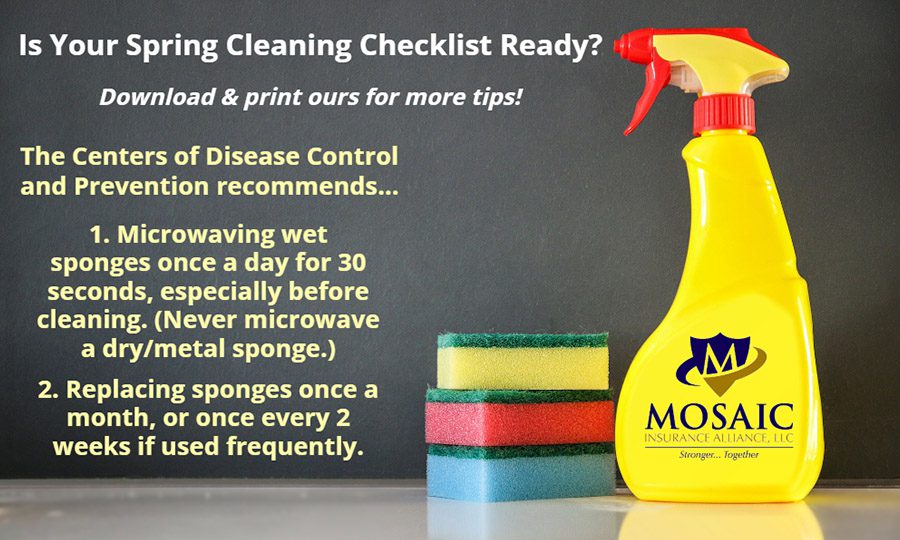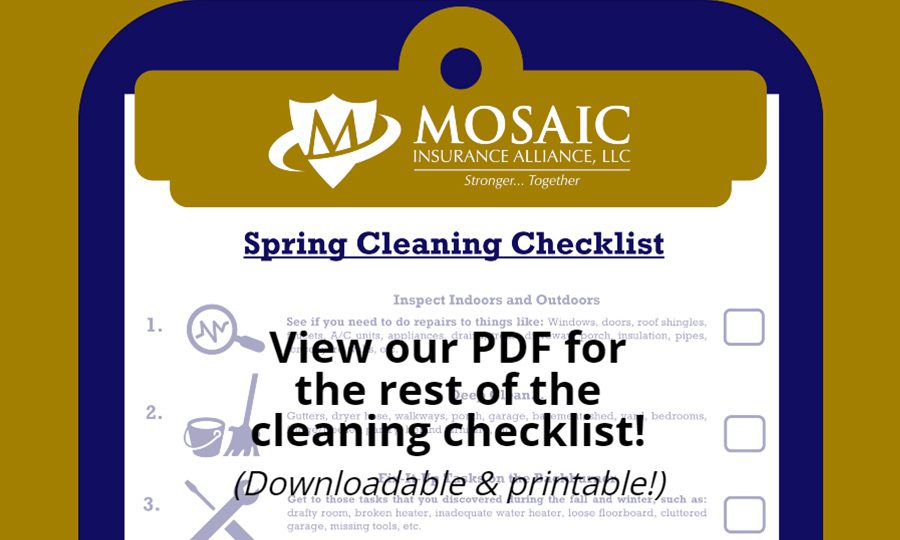Cleanliness can protect your health and prevent insurance claims
Insurance is life’s safety net for the unpredictable. We are all for insurance here at Mosaic, but we also believe in preventing the foreseeable.
Insurance is a backup plan to protect your property and finances. You can call us at 425-320-4280 , or fill out our form, to get a free quote for your car, home, business, boat, and more. But, what about the acts that lead up to the reason why we need insurance in the first place? We are not here just to help you get coverage. To help you avoid accidents or the need to file a claim, we did some research on what things to add to your to-do list this spring, as well as cleaning tips to do all-year-round.
Spring Cleaning Checklist:
Keeping up with house and car maintenance this spring can help you avoid costly damages and stressful insurance claims. Below is a handy infographic that you can share this spring! Click the picture or click here to view the downloadable and printable PDF.
When inspecting indoors and outdoors…
- Look to see if repairs are needed for items like windows, doors, roof shingles, faucets, A/C units, appliances, drains, trees, driveways, porches, insulation, pipes, fences, and yard walls.
When deep cleaning…
- Some items that frequently do not get cleaned enough include gutters, dryer hoses, sheds, garages, freezers, and furniture.
- Other important things to clean this spring include walkways, porches, basements, yards, gardens, spare bedrooms, and fridges. Also, don’t forget about cleaning behind and under furniture and appliances!
- Focus on your year-round routine and what you normally have time for. To give you some ideas on things to consider cleaning this spring, visit Good Housekeeping’s spring-cleaning gallery.
- See if you have a mold problem. Mold can cause sickness. It can also do permanent damage to your home and car that can also cause injury and thus result in a claim(s). Click here for some tips to prevent and get rid of mold and mildew.
When doing fix-it-up tasks…
- We all discover things during the fall and winter that should be repaired. Those backburner tasks tend to get pushed to spring.
- This spring make sure that those items are dealt with. Common ones include: drafty rooms, broken heaters, inadequate water heaters, loose floorboards, and cluttered garages.
- It is also common during other times of the year to realize that you are missing important tools—like that specific size wrench that tightens your car battery. Make a list this spring of the different tools that you need to replace/fix so that you have what you need the rest of the year.
What should you update this spring?
- Change all your smoke detector batteries, and make sure that you have plenty of backup batteries.
- Maintenance your lawnmower—you are going to be needing it soon!
- Replenish your storage items—food, lightbulbs, sponges, soap, candles, etc.
- If you have a fire extinguisher, make sure it is not expired. If you do not have one, consider getting one.
- Update your electronics
- For example, update your home security system and computer firewall to help avoid burglary and identity theft.
- Also, check and see if you have electronics that are old and/or damaged. You don’t want to be using something that can start an electrical fire. Plus, updating electronics can help you use less energy to save on your power bill.
How can you declutter your house?
- Downsizing each spring can help you declutter your home for safer living.
- Spring is the perfect time of the year to gather items for a garage sale. And, if you decide you don’t want to do a garage sale this spring or summer, you can donate items to a local thrift store.
- Go through each room of your house, garage, shed, etc. Look in cabinets, drawers, closets, storage containers, shelves, and the like. While you are looking, ask yourself: What items do I have that I no longer need, use, or want?
- Do you have duplicates of anything? Determine if you really need that many of one item.
- Pay special attention to clothes. Are there outfits that you don’t really wear? Do you have socks with lots of holes that should just be thrown away? What about clothes that are no longer the right size?
- Also, look for non-working items that no longer serve you that can be fixed or recycled by someone else. If you find some, donate them to appropriate places (i.e. an appliance recycle company might be interested in your old chest freezer you no longer want).
- If an item, cannot be used by someone else, like something broken beyond repair, throw it away appropriately.
When inspecting your car…
- Organize compartments like your center console, glove compartment, trunk, seat organizers, etc.
- With the hot weather coming, now is a good time to treat leather seats.
- Vacuum the carpet and seats, especially under and between the seats where things get lost and trapped.
- Install a garbage can/bag is you have not already.
- Remove debris from under the hood. (This time of year, it is common for leaves to get trapped under there.)
- Do some basic maintenance, such as: replace wipers, check fluids, check tire tread/pressure, etc.
- Replenish your emergency kits. Have a first aid kit with fresh band aids, ointment, gauze, disinfectant wipes, medical tape, etc. Have a roadside emergency kit that is equipped with jumper cables, basic tools like a wrench, flares, gloves, window breaker, seatbelt cutter, and flashlight. Also, having a car manual for your make, year, and model can help you with basic tasks that you need to know in the moment—i.e. how to jump a car.
A Handful of Handy Cleaning Tips:
Now that you have your list of general items to clean and maintenance this spring, what are some helpful things to consider when doing it? Below are some tips that you might find useful all-year-round!
1. How do you clean a sponge?
- Microwave
- The Centers of Disease Control and Prevention (CDC) recommends that you microwave your sponges once a day for 30 seconds, especially before cleaning. Their studies have shown that doing so kills 99.9% of germs.
- Make sure that they are wet before microwaving, and that you monitor time intervals since microwaves can vary in strength levels.
- Be cautious when removing sponges from the microwave, since they will be hot.
- Make sure to never microwave a dry sponge, or one that has metal.
- Dishwasher
- Good Housekeeping says to add sponges to a regular load of dishes, which can kill 99.9% of germs.
- Great spots to add them are the top shelf or the silverware container.
- Soaking
- Good Housekeeping found that soaking a sponge in vinegar or bleach can also kill most germs.
- Place it in non-diluted vinegar for 5 minutes (kills 99.6% of germs).
- Place it in bleach water for 5 minutes (kills 99.9% of germs).
- For the mixture, do 3/4 cups of bleach to 1 gallon of water.
- Be cautious of where you will be cleaning and around who. If you have little kids or pets, and/or will be cleaning a service that could be stained by bleach, using the vinegar method might be a better option.
2. How do you clean a coffee machine?
- Do not put coffee grounds down the sink, dishwasher, or toilet. Remove grounds by adding some water to the container and dump them into a strainer over the sink. Discard the grounds in the garbage. Coffee grounds can clog drains, pipes, and sewage tanks.
- Cleaning your standard coffee machine:
- After each pot of coffee, wash the removeable pieces with soap and water.
- Decalcify once a month with vinegar. Hard water minerals build up in internally in coffee machines over time. Cleanse your coffee machine by adding a equal-part water-vinegar mixture to the water reservoir, inserting an empty paper filter, and brewing like normal. Good Housekeeping recommends brewing halfway, letting the coffee machine sit for 30 minutes, and then brewing the rest. They also say that after the vinegar-water brew is done, you should replace the paper filter and brew another a pot with only water.
- Cleaning your Keurig coffee maker:
- Wash the removeable pieces at least once a week with soap and water (water reservoir, lid, mug tray, and K-cup holder).
- After washing the water reservoir and lid, let them airdry to avoid towel lint.
- To wash the main part of the machine, unplug it, remove the water reservoir and the water filter, and it with a damp sponge.
- Do not clean the water filter—those are to be replaced when needed. They are recommended by Keurig to replace every two months. When you get a new filter, follow these steps.
- Read here for more tips like cleaning the Keurig needle and descaling your machine.
- Cleaning your French press:
- If machine washable, after removing the grounds, disassemble all the parts and stick them in your dishwasher on the top wrack.
- To wash by hand, remove the grounds, add some water and soap to the container, put on the lid, and move the plunger up and down. Then rinse all the pieces.
- You can also soak the pieces in vinegar to disinfect them. After soaking, rinse and air dry.
3. How do you clean a cutting board?
- Don’t just rinse off a cutting board. Immediately wash it with soap, water, and a clean sponge. Same thing goes for the knife you are using.
- Be more cautious when cutting raw meat. Cleaning the countertop where the cutting board was, as well as the sink faucet handle, can help you eliminate leftover meat remnants.
- Also, Sears Home Services recommends that you have different colored cutting boards designated to different items. If you designate three different colors—one for fruits/veggies, another for meat, and a third for fish—you can avoid cross-contamination better.
Looking for some more cleaning tips? Good Housekeeping has tons on all kinds of topics. Check out their gallery and blog! Sears Home Services also has a handy kitchen interactive diagram of where most germs are located—just click on the spots to read a cleaning tip. And, if you still want more, the CDC is a great resource for how to clean up to code for all kinds of household items in their blog post here.
Information provided by: Mosaic, Travelers, Safeco, AAA, Cars.com, Centers of Disease Control and Prevention, Sears Home Services, GoodHousekeeping.com, and Keurig.


